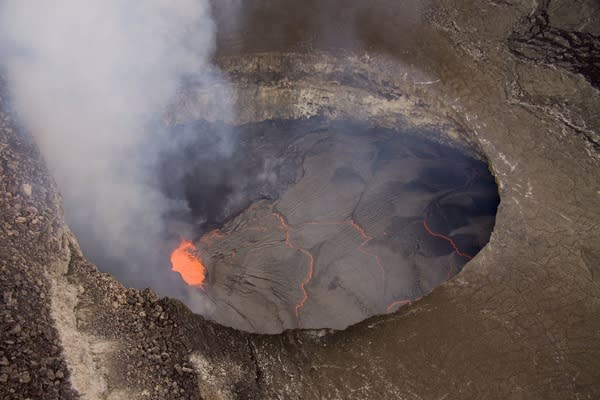Kilauea Lava Lake Hits Record Height

The steaming lava lake in a vent near the summit of Hawaii's Mount Kilauea recently hit its highest level since the vent opened in 2008, according to the U.S. Geological Survey's Hawaiian Volcano Observatory.
The record was reached Oct. 14, when the lava rose to within 150 to 165 feet (45 to 50 meters) of the top of the nearly vertical vent, the USGS said. The lava continues to fluctuate but has remained high over the past few days, said Jim Kauahikaua, scientist-in-charge of the HVO.
The vent is inside Halema'uma'u Crater atop Kilauea, one of the world's most active volcanoes. The lava lake rises and falls as magma levels change within the volcano.
"The lake is probably the top of an open conduit into a shallow magma chamber and, therefore, reflects pressure changes within the reservoir," Kauahikaua told OurAmazingPlanet in an email interview." Inflation goes with a pressurizing reservoir and can be expressed as the rising level of the lava lake."
The summit lava lake sits deep within the 520-foot-wide (160 m) cylindrical vent in Halema'uma'u Crater. The vent has been almost continuously active since it began spewing lava on March 19, 2008. [Watch the lava lake erupt.]
For the past several months, the lava lake has been slowly rising. The summit itself has been slowly inflating since early August, Kauahikaua said.
One possible outcome of the rising lava lake level and the expanding Kilauea summit is a future outpouring of lava into Halema'uma'u Crater.
"If this trend continues, we may expect the summit lava lake to continue rising slowly until there is a rupture somewhere within the subsurface transport system, carrying magma to the east rift zone eruption site," Kauahikaua said.
Heat from the high lava lake level is also causing the walls of the vent above the lava surface to expand and fracture. This is creating cracking and booming noises, the USGS said in a statement.
Reach Becky Oskin at boskin@techmedianetwork.com. Follow her on Twitter @beckyoskin. Follow OurAmazingPlanet on Twitter @OAPlanet. We're also on Facebook and Google+.
Copyright 2012 OurAmazingPlanet, a TechMediaNetwork company. All rights reserved. This material may not be published, broadcast, rewritten or redistributed.


